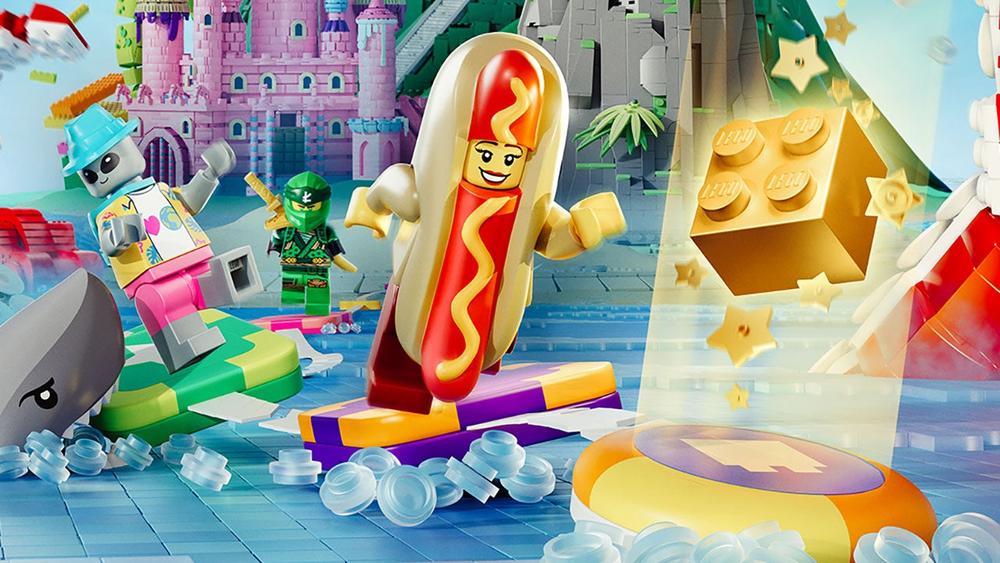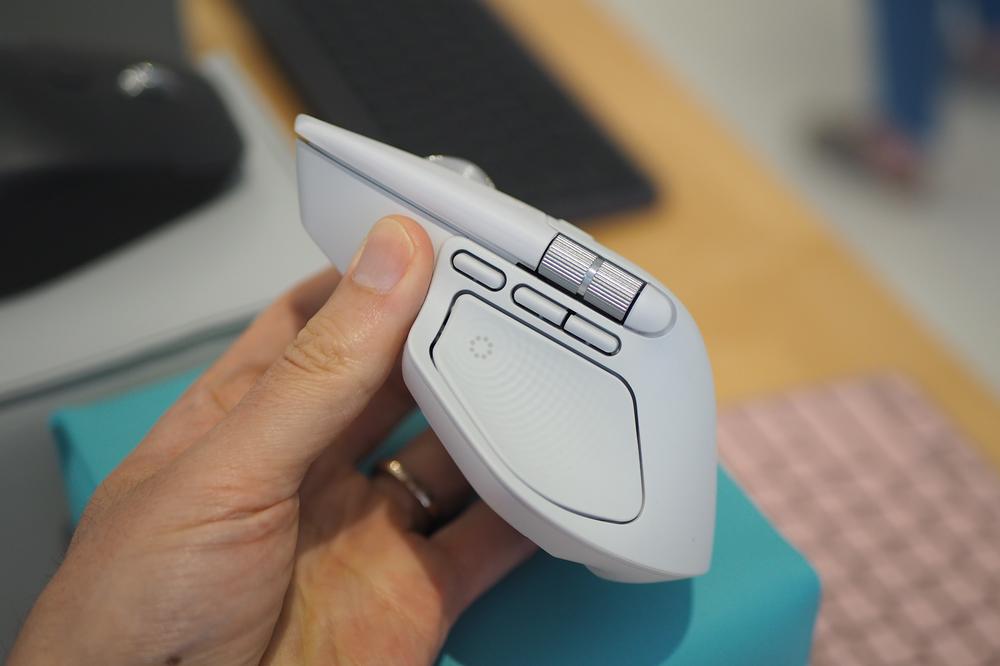Given that the LEGO brand has been slapped onto almost every kind of family-friendly multiplayer game you can think of at this point, from kart racers to Super Smash Bros clones and even a Rock Band spin-off, it’s surprising that it’s taken this long for the world’s biggest brick maker to construct its own monument to Mario Party. LEGO Party is something more than a block-based knockoff of Nintendo’s long-running virtual boardgame series, though. Sure, it might use Mario Party’s fundamentals as a baseplate to build upon, with a host of wacky minifigs in place of the Mushroom Kingdom’s finest, but every last piece here is absolutely pulsating with personality and there isn’t a single stud-based dud in the 60 minigames on offer. If lots of laughter is what you’re after, LEGO Party has all the right parts for assembling a fun night in with friends and family.
If you’ve ever played one of Nintendo’s party-starters before then the basics of LEGO Party will be as easy to grasp as a tiny coffee mug in a minifig’s fist. In this instance, the goal is to collect gold bricks and studs instead of stars and coins, as you and three other players move around four uniquely themed game boards littered with various stud-sapping hazards and potentially lucrative event spaces to land on. Depending on the board you choose, each session can be as short as six rounds or roughly 45 minutes but can be extended all the way up to three-hour-long, 24-round epics, and each round pits all four players against each other in a minigame designed to be easy to pick up for LEGO Juniors and old-timer Technic fans alike, but tricky to master.
Everybody can carry up to three power-ups that can be bought with studs at the shop or collected from Wheel of Fortune-style spins, and these can have dramatic leaderboard-levelling impacts, like teleporting your minifig directly to a gold brick space, or slowing your roll so you can increase your chances of moving the exact number of spaces you need. Many of these basics have been established in the Mario Party blueprint several times over, and Lego Party takes an ‘if it ain’t broke, don’t fish the dog-eared instruction booklet out of the toy chest and rebuild it’ approach to keeping many of these proven core concepts intact.
However, there are some key elements to be found in LEGO Party’s Pirate, Ninjago, Space, and Theme Park boards that set them apart. For starters, each minigame is chosen democratically by moving your minifig in front of one of three options presented at the beginning of each round, and I liked that it meant my party was given a bit more control over which events we were able to enjoy in each evening’s session. (Of course, if you prefer a more randomised minigame experience like Mario Party, you can opt for that too.) I also prefer LEGO Party’s system of letting the results of each minigame determine the order of turns in each subsequent round, as opposed to Mario Party’s more rigid setup of dictating the order via a dice roll at the start and sticking with that all the way to the end. I find that LEGO Party’s results-driven method increases the ebb and flow of each board and brings extra incentive to do well in each minigame.
More notably, each of LEGO Party’s wonderfully candy-coloured and brilliantly detailed boards has a number of special construction zones to land on, giving you the choice of two structures to build on that space that can dramatically alter the map and introduce a variety of game-changing additions. For example, in the Theme Park board you might opt to build the Extreme Zone, which introduces a gauntlet run of twitchy stunt challenges to successfully pull off in order to earn a gold brick. Alternatively you could go for the Royal Ramparts, which brings with it a ballista-based minigame for quickly snaring studs, and a catapult for lobbing you at another random player and stealing one of their gold bricks. Mixed in with the various other board-specific features, like when the Space map briefly transforms into a turn-based battle against a giant green alien, and each go-around of these game boards has felt fresh and fun over the dozen or so hours of playtime my family and I have put in together so far.
Everything is Awesome
It’s also been consistently funny, and that’s largely due to the inclusion of Ted Talker and Paige Turner, LEGO Party’s own quip-cracking commentary team. Seemingly inspired by gag-making game show playcallers like those of Wipeout or Holey Moley, Ted and Paige provide colourful context to each turn taken, as well as responding in real time to each player’s performance in a minigame – either bigging them up when they’re on top, or hilariously dragging them when they’re struggling. Surprisingly, even after multiple playthroughs of each of LEGO Party’s four boards I’ve barely heard the same joke twice, although in fairness that could be because half the time the commentary has been completely drowned out either by fits of uncontrollable laughter or salty bickering as a hard-earned gold brick is ruthlessly snatched away from another player. Seriously, if you’re playing with a competitive group, that tends to sting harder than suddenly finding a lost LEGO brick with the fleshy part of your bare foot.
The rest of the comedy in LEGO Party stems from the competitive chaos of the challenges themselves, and developer SMG Studio – who previously entertained with the slapstick-based shenanigans of its Moving Out series – has really outdone itself as far as crafting a construction derby of morish minigames. From memory-testing challenges to physics-driven races and rhythm-based dance-offs, Lego Party’s roster of minigames is as diverse as it is diverting, dripping with personality and creative flair. Besides, it’s always a great indication for how immediately engaging multiplayer minigames are when players get caught up in the competition without realising they haven’t even left the pre-game practice screen, which has been a regular occurrence during my time with LEGO Party so far.
Some minigames are terrific, toybox tributes to other titans of multiplayer mayhem, such as the obstacle course dash that feels straight out of Fall Guys or the zero-gravity space shuttle soccer that’s very much in the same orbit as Rocket League. Others lean into the familiarly tactile feel of playing with LEGO itself, like the one that involves trying to build monsters out of a pile of different-shaped blocks without being provided any instructions. There’s one challenge with four soccer goals to defend from an ever-increasing number of balls that plays out like an inverted game of Hungry Hungry Hippos, and another that sits each minifig on a LEGO motorbike and challenges you to navigate an undulating course like a cutesy recreation of Trials HD.
Some of the most popular minigames amongst the contestants on my couch are the ones that feel like nothing else we’ve ever played. There’s the frantic, four-way battle to smash your opponents’ LEGO vase with a brick boulder that gradually speeds up as it’s deflected off each player, or the nightclub-themed showdown that sees each of you scramble to fling your minifig onto a floating dance floor with elastic grappling hooks. Of course, everyone in my party has their own personal picks: I love anything on four-wheels, my son’s really into the zero-gravity games, while my daughter’s favourite is… basically whichever minigame she won most recently. But the quality of challenges here is so consistent across the game board, that even when we opt for a random minigame choice we’re rarely disappointed with whatever comes our way.
Everything is Cool When You’re Part of a Team
I also appreciate that success in these minigames is mostly reliant on a combination of skill and luck. You won’t find any cheap button-mashing challenge types here like the ones that often pop up in Mario Party, which I always felt put unnecessary wear and tear on my expensive game controllers, not to mention seeming somewhat unfair to the younger players in my lounge room who haven’t had decades of button-pressing practice pumped into their biceps.
There also aren’t any lopsided three-vs-one match types to force the majority to unfairly gang up on an individual, as LEGO Party’s minigames are always evenly split – either every man for himself, or face-offs in teams of two on the occasions you land on a Brick Battle square. These team-based clashes range from the pure intensity of a doubles game of air hockey through to more ridiculous co-op tasks where one person aims a T-shirt cannon and the other fires it at an audience of shirtless minifigs, and all of them demand effective communication and coordination between duos in order to get the win. In fact, I enjoyed these Brick Battles so much that I was slightly disappointed to find there were only nine of them included in the roster.
Even so, I am happy that LEGO Party doesn’t bother with random participation awards at the end of each board, like many Mario Party games do. There’s still plenty of twists and turns as fortune-changing chance spaces are sprinkled across the map in the closing stages, and many games I’ve played have seen the lead constantly change hands all the way through to the final round, but the winner is always clearly defined by the time you reach the end – not unfairly elevated into first position after the fact purely because of some arbitrary, unseen statistic like they happened to land on the most event spaces. It makes victory feel like it was achieved through genuine merit rather than more mystifying means. That doesn’t mean that other players won’t take any opportunity to knock you off the winner’s podium, though – and I mean that quite literally, especially during the riotously interactive results screen that typically devolves into delirious slap fights, slipping on banana peels, and background breakdancing.
While LEGO Party’s lineup of playable minifigs might not feature anyone as iconic as Mario or Yoshi, it makes up for it in terms of sheer numbers and the substantial suite of options for character customisation. Playing through each of the game boards or one of the curated minigame playlists earns XP that gradually unlocks new minifigs along a series of simple progression paths, as well as awarding you carrots that can be spent unlocking a separate collection of minifigs in the shop. There are more minifigs here than you could shake a mini twig at – by my count well over 200, from goth kid minifigs to person-shaped pizza slices and stylish ninja warriors – and as you unlock each one their individual parts can be used to craft entirely new creations of your own. Want a minifig with tigerprint pants, a Miami Vice-style linen jacket, and an American football helmet? Weird combination but sure, it’s all yours.
Speaking of bolting things together, I’d love to see LEGO Party leverage the many pop culture partnerships that the Danish brickmaker has amassed over the years and bring them to the party either in the form of expansion packs or future sequels. A LEGO Star Wars board with minigames designed around lightsaber battles and Death Star trench runs would be a treat, as would a LEGO Indiana Jones board that had event spaces to trigger Raiders of the Lost-ark style booby traps and boulders. Given Nintendo’s cosying up with the LEGO brand in recent times, it’s not inconceivable that we could even see a LEGO Mario LEGO Party expansion, at least in the Switch versions, to really bring things full circle. To be clear, nothing of this nature has been announced and I’m merely thinking out loud, but I’ve had a blast with LEGO Party so far, and I really hope that it’s set the fantastic plastic foundations for a series that’s here to stay.

 Logitech’s MX Master 4 adds haptic feedback, mostly just for fun
Logitech’s MX Master 4 adds haptic feedback, mostly just for fun